HONDA S2000 2000 1.G Owners Manual
Manufacturer: HONDA, Model Year: 2000, Model line: S2000, Model: HONDA S2000 2000 1.GPages: 273, PDF Size: 21.58 MB
Page 191 of 273
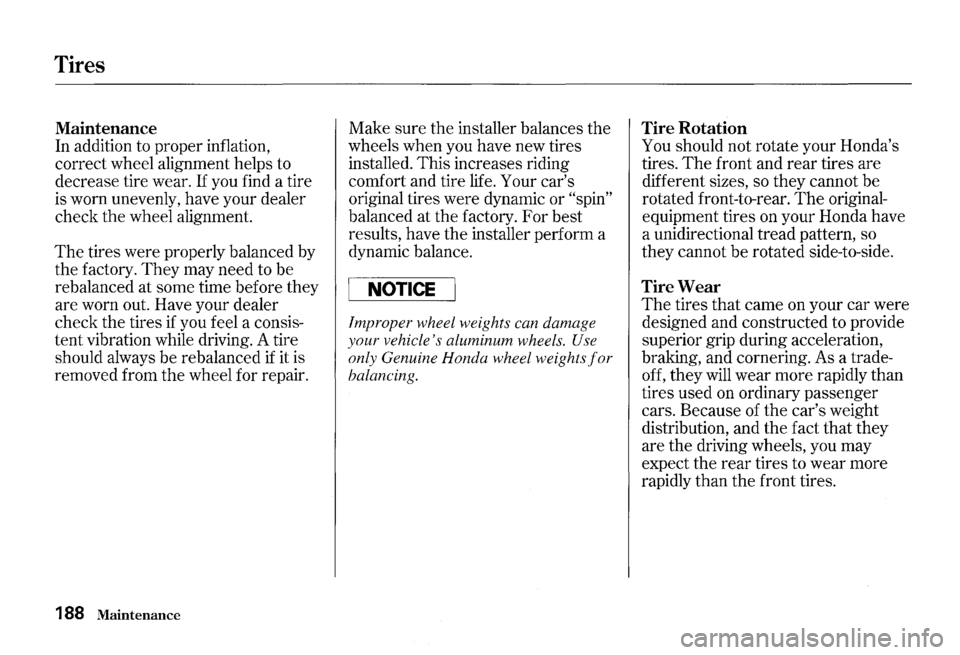
Tires
Maintenance
In addition to proper inflation,
correct wheel alignment helps to
decrease tire wear.
If you find a tire
is worn unevenly, have your dealer
check the wheel alignment.
The tires were properly balanced by
the factory.
They may need to be
rebalanced at some time before they
are worn out. Have your dealer
check the tires
if you feel a consis
tent vibration while driving. A tire
should always be rebalanced if it is
removed from
the wheel for repair.
188 Maintenance
Make sure the installer balances the
wheels when you have new tires
installed. This increases riding
comfort and tire life.
Your car's
original tires were dynamic or
"spin"
balanced at the factory. For best
results, have the installer perform a
dynamic balance.
NOTICE
Improper wheel weights can damage
your vehicle's aluminum wheels.
Use
only Genuine Honda wheel weights for
balancing.
Tire Rotation
You should not rotate your Honda's
tires.
The front and rear tires are
different sizes, so they cannot be
rotated front-to-rear.
The original
equipment tires on your Honda have
a unidirectional tread pattern, so
they cannot be rotated side-to-side.
Tire Wear
The tires that came on your car were
designed and constructed to provide
superior grip during acceleration,
braking, and cornering. As a trade
off, they
will wear more rapidly than
tires used on ordinary passenger
cars. Because of the car's weight
distribution, and the fact that they
are the driving wheels, you may
expect the
rear tires to wear more
rapidly than the front tires.
Page 192 of 273
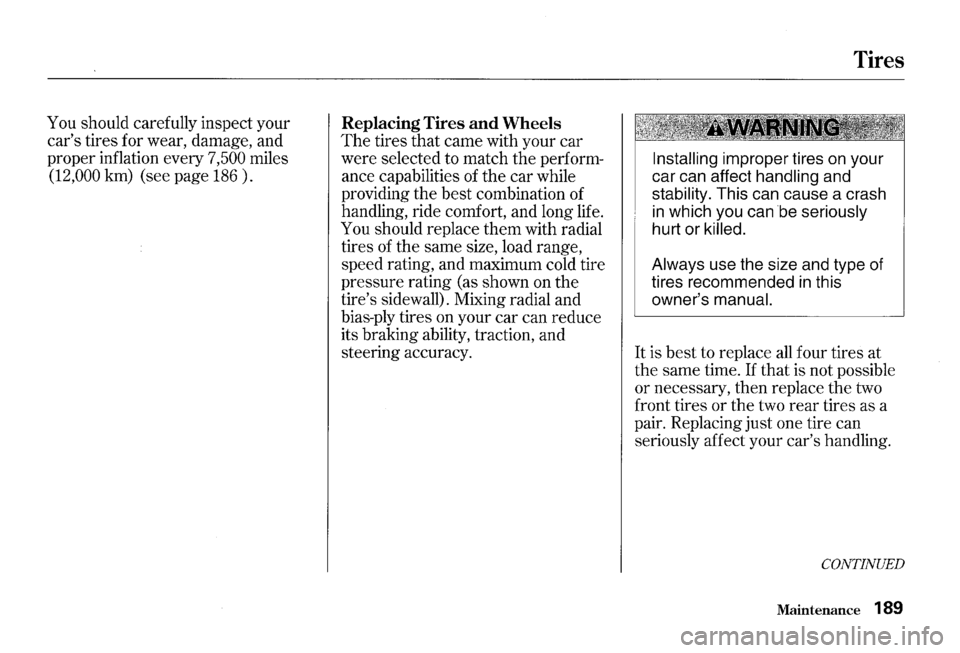
You should carefully inspect your
car's tires for wear, damage, and
proper inflation every
7,500 miles
(12,000 km) (see page 186 ) .
Replacing Tires and Wheels
The tires that came with your car
were selected to match the perform
ance capabilities of the car while
providing the best combination of
handling, ride comfort, and long life.
You should replace them with radial
tires of the same size, load range,
speed rating, and maximum cold tire
pressure rating (as shown on the
tire's sidewall). Mixing radial and
bias-ply tires on your car can reduce
its braking ability, traction, and
steering accuracy.
Tires
Installing improper tires on your
car can affect
handling and
stability. This can cause a crash
in which you can be seriously
hurt or killed.
Always
use the size and type of
tires recommended
in this
owner's
manual.
It is best to replace all four tires at
the same time. If that is not possible
or necessary, then replace the two
front tires or the two
rear tires as a
pair. Replacing just one tire can
seriously affect your car's handling.
CONTINUED
Maintenance 189
Page 193 of 273
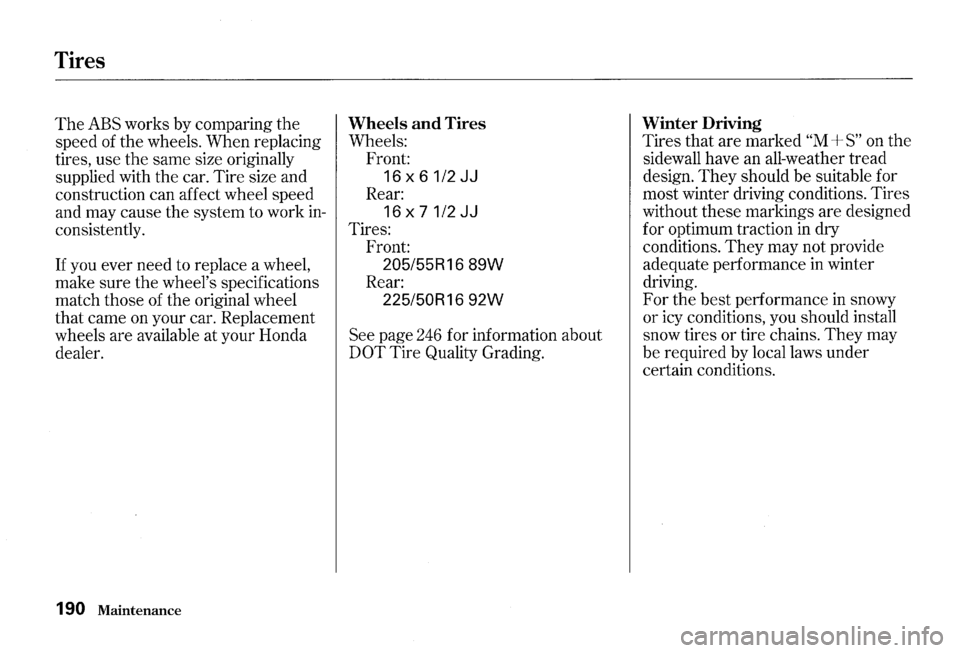
Tires
The ABS works by comparing the
speed of the wheels. When replacing
tires, use the same size originally
supplied with the car. Tire size and
construction can affect wheel speed
and may cause the system to work
in
consistently.
If you ever need to replace a wheel,
make sure the wheel's specifications
match those of the original wheel
that came on your car. Replacement
wheels are available at your Honda
dealer.
190 Maintenance
Wheels and Tires
Wheels:
Front:
16x61/2JJ
Rear:
16x71/2JJ
Tires: Front:
205/55R16 89W
Rear:
225/50R16 92W
See page 246 for information about
DOT Tire Quality Grading.
Winter Driving
Tires that are marked "M + S" on the
sidewall have an all-weather tread
design.
They should be suitable for
most winter driving conditions. Tires
without these markings are designed
for optimum traction in dry
conditions.
They may not provide
adequate performance in winter
driving.
For the best performance in snowy
or icy conditions, you should install
snow tires or tire chains.
They may
be required by local laws under
certain conditions.
Page 194 of 273
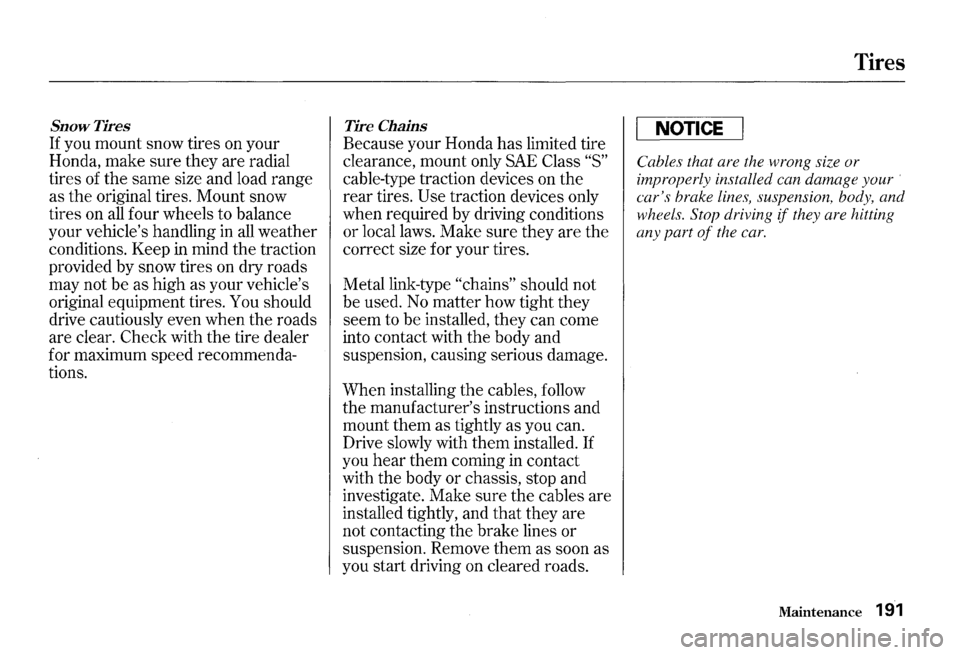
Snow Tires
If you mount snow tires on your
Honda, make sure they are radial
tires of the same size and load range
as
the original tires. Mount snow
tires on
all four wheels to balance
your vehicle's handling in all weather
conditions. Keep
in mind the traction
provided by snow tires on dry roads
may not be as high as your vehicle's
original equipment tires. You should
drive cautiously even when the roads
are clear. Check with the tire dealer
for maximum speed recommenda
tions.
Tire Chains
Because your Honda has limited tire
clearance, mount only
SAE Class "S"
cable-type traction devices on the
rear tires.
Use traction devices only
when required by driving conditions
or local laws. Make sure they are the
correct size for your tires.
Metal link-type
"chains" should not
be used.
No matter how tight they
seem to be installed, they can come
into contact with the body and
suspension, causing serious damage.
When installing
the cables, follow
the manufacturer's instructions and
mount
them as tightly as you can.
Drive slowly with them installed.
If
you hear them coming in contact
with the body or chassis, stop and
investigate. Make sure the cables are
installed tightly, and
that they are
not contacting the brake lines
or
suspension. Remove them as soon as
you start driving on cleared roads.
Tires
NOTICE
Cables that are the wrong size or
improperly installed can damage your ·
car's brake lines, suspension, body, and
wheels. Stop driving (l they are hitting
any part
of the car.
Maintenance 191
Page 195 of 273
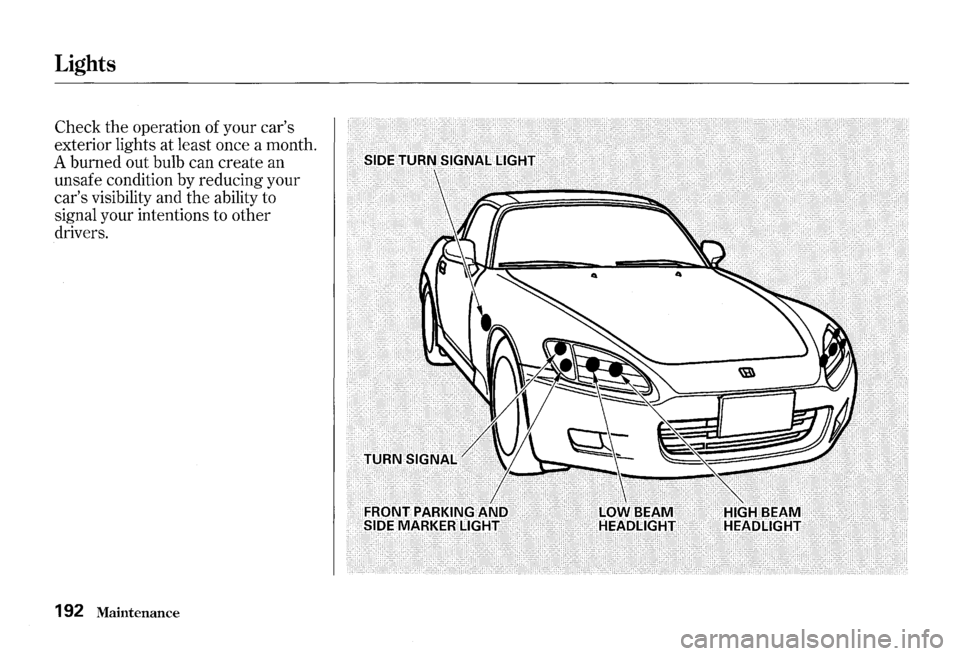
Lights
Check the operation of your car's
exterior lights at least once a month.
A burned out bulb can create an
unsafe condition
by reducing your
car's visibility and the ability to
signal your intentions to other
drivers.
192
Maintenance
Page 196 of 273
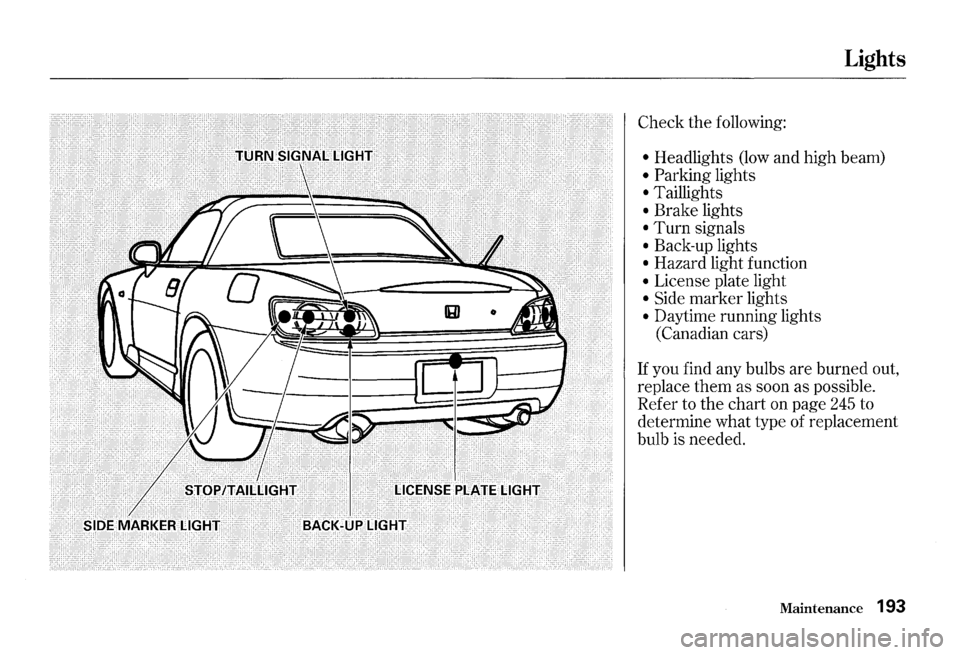
Lights
Check the following:
• Headlights (low and high beam)
• Parking lights
• Taillights
• Brake lights
• Turn signals
• Back-up lights
• Hazard light function
• License plate light
• Side marker lights
• Daytime running lights
(Canadian cars)
If you find any bulbs are burned out,
replace
them as soon as possible.
Refer to the chart on page
245 to
determine what type of replacement
bulb is needed.
Maintenance 193
Page 197 of 273
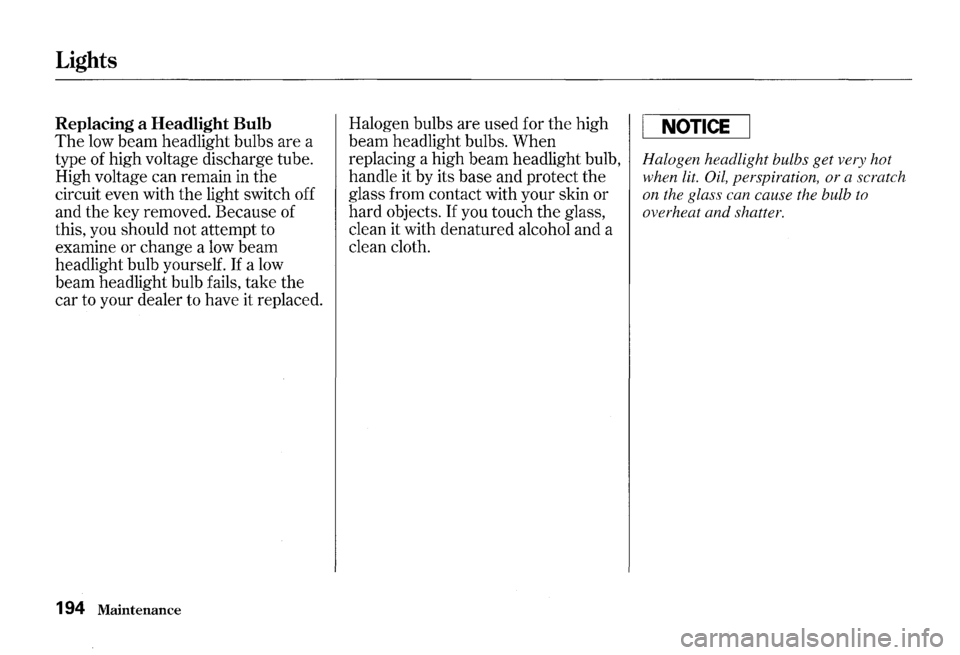
Lights
Replacing a Headlight Bulb
The low beam headlight bulbs are a
type of high voltage discharge tube.
High voltage can remain in
the
circuit even with the light switch off
and the key removed. Because of
this, you should not attempt to
examine or change a low beam
headlight bulb yourself.
If a low
beam headlight bulb fails, take the
car to your dealer to have it replaced.
194 Maintenance
Halogen bulbs are used for the high
beam headlight bulbs.
When
replacing a high beam headlight bulb,
handle it by its base and protect the
glass from contact with your skin or
hard objects.
If you touch the glass,
clean it with denatured alcohol and a
clean cloth.
NOTICE
Halogen headlight bulbs get very hot
when
lit. Oil, perspiration, or a scratch
on the glass can cause the bulb to
overheat and shatter.
Page 198 of 273
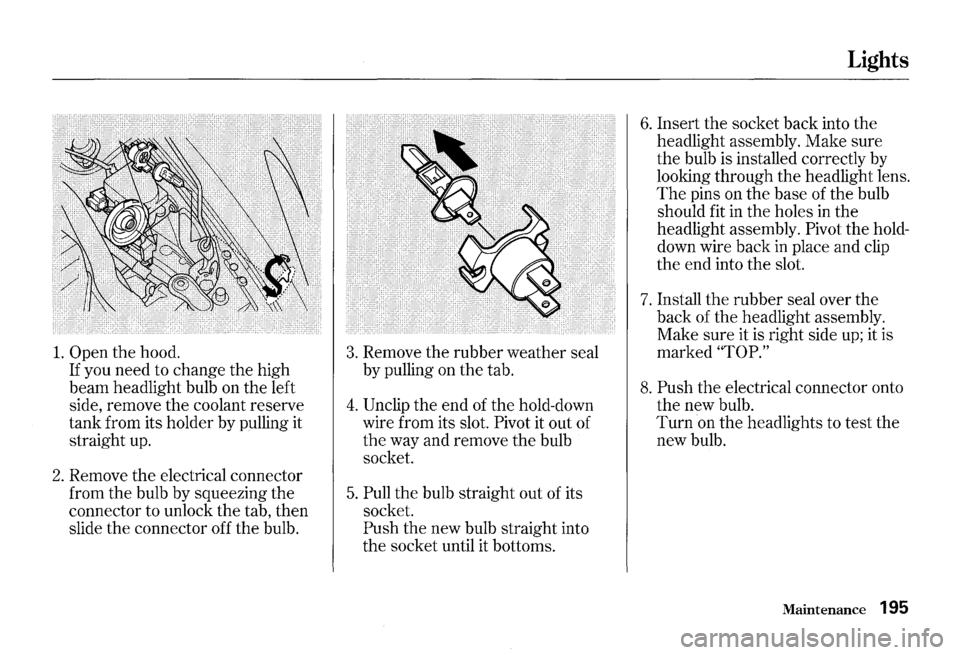
1. Open the hood.
If you need to change the high
beam headlight bulb on the left
side, remove the coolant reserve
tank from its holder by pulling it
straight up.
2. Remove the electrical connector
from
the bulb by squeezing the
connector to unlock the tab, then
slide
the connector off the bulb.
3. Remove the rubber weather seal
by pulling on the tab.
4. Unclip the end of the hold-down
wire from its slot.
Pivot it out of
the way and remove the bulb
socket.
5. Pull the bulb straight out of its
socket.
Push the new bulb straight into
the socket until it bottoms.
Lights
6. Insert the socket back into the
headlight assembly. Make sure
the bulb is installed correctly by
looking through the headlight lens.
The pins on the base of the bulb
should fit in
the holes in the
headlight assembly.
Pivot the hold
down wire back in place and clip
the end into the slot.
7. Install the rubber seal over the
back of
the headlight assembly.
Make sure it is right side
up; it is
marked
''TOP."
8. Push the electrical connector onto
the new bulb.
Turn on the headlights to test the
new bulb.
Maintenance 195
Page 199 of 273
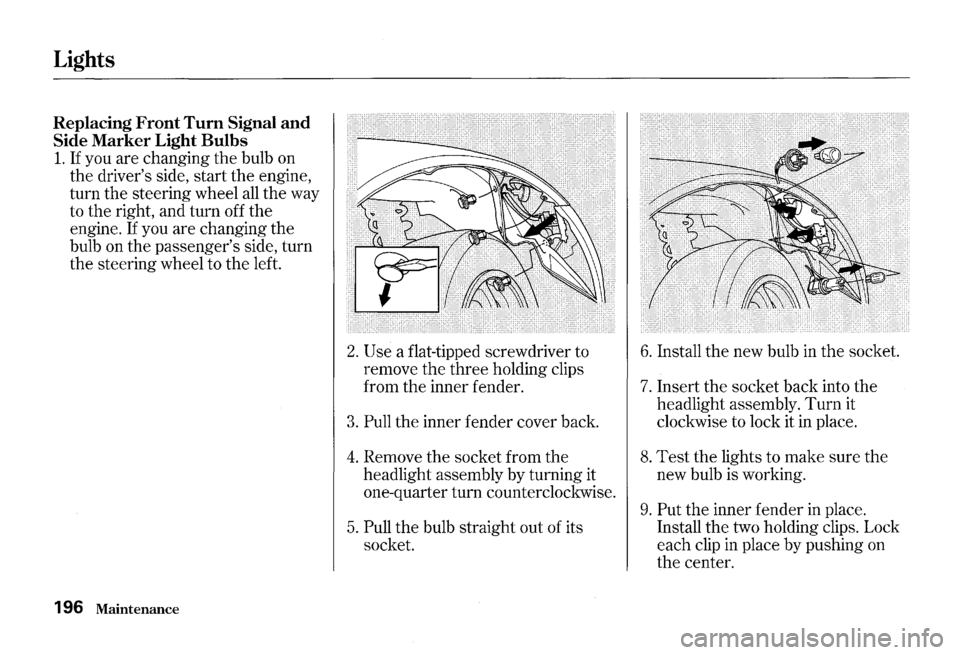
Lights
Replacing Front Tum Signal and
Side Marker Light Bulbs
1. If you are changing the bulb on
the driver's side, start the engine,
turn the steering wheel
all the way
to the right, and turn off the
engine.
If you are changing the
bulb on the passenger's side, turn
the steering wheel to the left.
196 Maintenance
2. Use a flat-tipped screwdriver to
remove the three holding clips
from the inner fender.
3. Pull the inner fender cover back.
4. Remove the socket from the
headlight assembly by turning it
one-quarter turn counterclockwise.
5. Pull the bulb straight out of its
socket.
6. Install the new bulb in the socket.
7. Insert the socket back into the
headlight assembly.
Turn it
clockwise to lock it
in place.
8. Test the lights to make sure the
new bulb is working.
9. Put the inner fender in place.
Install the two holding clips. Lock
each clip in place by pushing on
the center.
Page 200 of 273
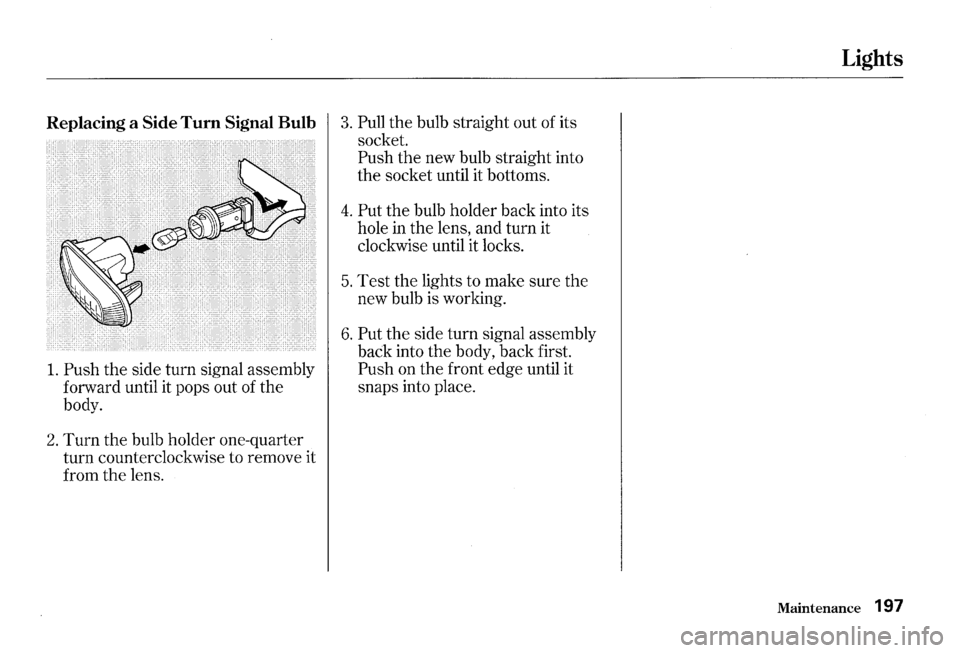
Replacing a Side Turn Signal Bulb 3. Pull the bulb straight out of its
1. Push the side turn signal assembly
forward until it pops out of
the
body.
2. Turn the bulb holder one-quarter
turn counterclockwise to remove it
from
the lens. socket.
Push the new
bulb straight into
the socket until it bottoms.
4. Put the bulb holder back into its
hole in
the lens, and turn it
clockwise until it locks.
5. Test the lights to make sure the
new bulb is working.
6. Put the side turn signal assembly
back into the body, back first.
Push on the front edge until it
snaps into place.
Lights
Maintenance 197